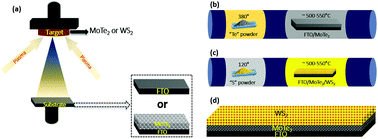Development of a WS2/MoTe2 heterostructure as a counter electrode for the improved performance in dye-sensitized solar cells†
Abstract
A facile large-area synthesis of a WS2/MoTe2 heterostructure via a sputtering–CVD approach on conductive glass substrates was demonstrated and, for the first time, it was used as a counter electrode (CE) for dye-sensitized solar cells (DSSCs). Cyclic voltammetry (CV), electrochemical impedance spectroscopy (EIS), and Tafel curves verified that the unique structure is beneficial for improving the catalytic activity for the reduction of triiodide to iodide and a low charge transfer resistance at the electrode/electrolyte interface. The thicknesses of the top and bottom layers of WS2/MoTe2 were varied to achieve high DSSC performance. Consequently, DSSCs assembled with the optimized WS2/MoTe2 CE reached a high power conversion efficiency (PCE) of 7.99%, which is comparable to the conventional Pt CE (8.50%) and their pristine WS2 and MoTe2 CEs (6.3% and 7.25%, respectively). Our findings create a way to prepare DSSCs with efficient performance.



 Please wait while we load your content...
Please wait while we load your content...